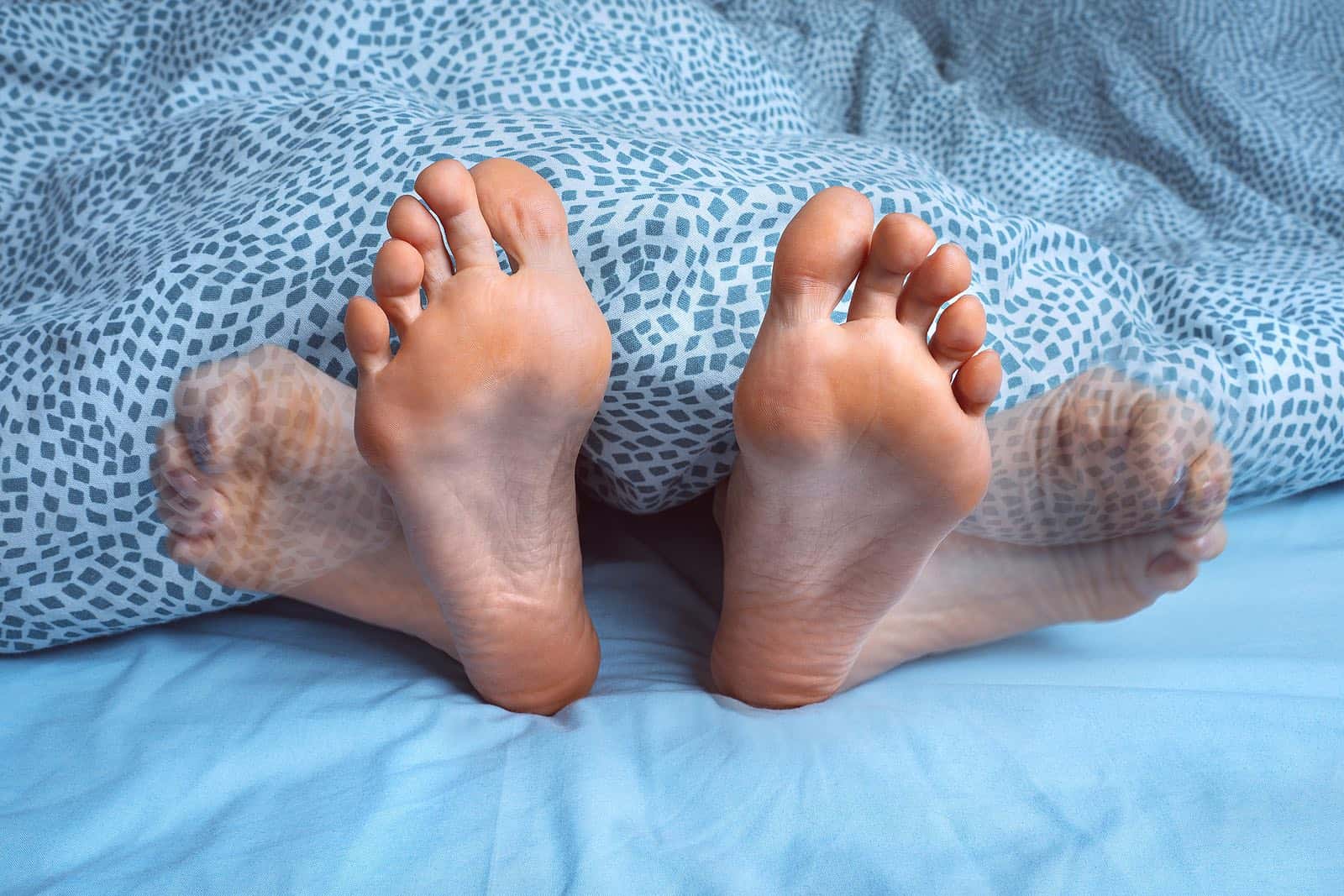
Restless Leg Syndrome (RLS) may not sound like a serious health problem unless you have experienced it. Compared to coronary heart disease, diabetes or cancer, RLS just doesn’t sound scary. But ask someone with this condition how it affects their life, and you might change your mind.
People who suffer with restless leg syndrome find it very hard to live with. As soon as they try to relax, their legs begin to itch, ache, throb or feel as though bugs were crawling on them. The feeling of pulling, tugging, burning or irritation inside the legs eases only when the victim moves the legs around. Even then, the discomfort may not disappear.
Some people get up and pace the floor, others climb stairs or jerk their legs in bed. One woman described a situation in which she ended up literally kicking her husband out of the bed. Because of her endless thrashing, he had to sleep in another room.
Sufferers may get very little sleep. Traveling in a car or on an airplane can turn into a nightmare. This is not merely uncomfortable. For some people, these relentless symptoms may trigger depression and thoughts of suicide. We do not use the suicide word lightly. When RLS becomes relentless and unremitting and drugs don’t control the symptoms or create new problems, people may become despondent. The Suicide & Crisis Lifeline number is 988.
What Does Restless Leg Syndrome Feel Like?
Here are some ways readers have described their RLS experience:
“For me it is chronic and gets worse as I get older. I’ve taken Mirapex and ropinirole. They worked at first and later lost their effectiveness.
“I go to a movement disorder specialist who has treated me with respect and worked hard to manage the symptoms, which involve the entire right side of my body.
“Recently a pharmacist refused to fill a prescription that keeps me free of symptoms. I panicked at the idea of going without the medication. My symptoms are sheer torture. Suicide seemed like the only thing that would release me from the torture.
“Then I found a pharmacist who would fill the prescription. She saved my life. RLS is no joke!”
Another agreed that this condition is can be overwhelming:
“RLS does make you consider suicide! I suffered from it for over 20 years. After seeing four neurologists and three primary care physicians, I finally got an appointment at a sleep medicine center.
“There I got a prescription for methadone. Although it’s controversial, it is truly my miracle drug!
“Anyone who has RLS should go online and join the Restless Leg Foundation. They offer a lifeline to RLS centers around the country. It could save your life as it helped save mine.”
Like the Wizard of Oz:
“As I think back to The Wizard of Oz, when the house fell on the wicked witch, her legs curled up under her. That is the way I describe RLS. Just sort of a creepy feeling.”
Another person explained:
“My father and sister have RLS. It never occurred to me that I did too, since my leg discomfort occurred both day and night. Years ago, I happened on a product containing choline that relieves RLS symptoms for me. If I take it daily, I am able to sleep comfortably at night and do not have the daytime symptoms of aching, tingling, and needing to stretch or move my legs.”
This reader had more trouble finding a solution:
“I have had an extreme case of RLS for several years. I have tried increasing calcium, magnesium and vitamin D, leg and full-body massages, diet changes, exercising and increasing my water intake. Nothing helped.
“My symptoms increased after a hip replacement 10 years ago. The doctor prescribed Requip and then Mirapex. However, the side effects are difficult to adjust to and make normal life activities dangerous. Plus, they do not relieve my symptoms enough to sleep more than a few hours. Out of desperation, I recently tried CBD oils and medical marijuana. The CBD oil helped very little, but the marijuana worked amazingly well within a few minutes, and I slept soundly for the first time in years! I will definitely be searching for a holistic doctor to pursue a medical marijuana prescription.”
Medications for Restless Leg Syndrome:
Until a few decades ago, doctors had no medications to alleviate RLS. Now there are drugs such as Requip (ropinirole), Mirapex (pramipexole) or Neupro (rotigotine) that work through the neurotransmitter dopamine.
While effective treatment for RLS can be a life saver, it can also ruin lives. Physicians prescribing drugs like ropinirole or pramipexole should warn their patients about the possibility that they might develop compulsive behaviors including gambling.
We heard from one man who wrote:
“I am a 45-year-old man and have been on Mirapex at the maximum dosage for 18 months now. In the past year, I have developed an obsession for shopping for men’s cologne and clothes. My fragrance collection has more than 300 colognes I could not afford.
“I have developed an addiction to pornography and sex too. I have driven my wife out of my bed, because I can’t resist my urges to constantly grope her and I guilt-trip her to have sex with me. In a typical day I masturbate and pressure my wife into some sort of sexual activity.
“I became obsessed with weightlifting and lost 30 pounds. On the meds I sleep well and can function without being tired. I have only now realized there could be a direct link with my activity to my meds. This drug has changed me and I don’t like it.”
Not everyone experiences compulsive behavior, but far too many individuals have lost money and family because of drugs prescribed for RLS.
Years ago, a woman wrote to us about a positive response to Mirapex for RLS:
“My husband has suffered from RLS for as long as I have known him. Until several years ago we didn’t even know it had a legitimate name. We called it ‘leg-i-tis’!
“He tried everything he could think of-calcium, magnesium, quinine, etc. His doctor told him to march around the house until it stopped. (This was usually done in the middle of the night since that was when it occurred.) It would start right back up when he laid down to try to sleep.
“I was watching ‘Good Morning America’ a while ago and heard about RLS. The doctor said a medication called Mirapex works.
“My husband’s doctor prescribed it for him and it has been a miracle for us. I say us because his horrible condition kept us both from sleeping.”
Pramipexole (Mirapex) is a medicine used to treat Parkinson’s disease. The FDA has also approved it to treat restless leg syndrome. The agency has also approved another drug for Parkinson’s disease, ropinirole (Requip), for treating RLS.
In one study, a low dose (1.8 mg) of Requip reduced the average number of leg twitches in sufferers from 49 per hour to just 12. The placebo was no match for this drug.
Side Effects of Medications for RLS:
No single solution works for everyone with this neurological condition. While ropinirole (Requip) or pramipexole (Mirapex) can ease RLS for many people, others find the side effects are worse than the original disease.
The most common side effects of both Mirapex and Requip include nausea and dizziness. Daytime fatigue or sleepiness is also a risk and makes driving or operating machinery dangerous. Other serious side effects include lightheadedness upon sitting or standing up. This can lead to fainting. Hallucinations and bizarre behavior as well as compulsive behavior such as gambling, binge eating, compulsive shopping or sexual promiscuity can cause people a lot of distress.
We got this report of such a reaction:
“I was on ropinirole for many years to relieve my RLS. Then I began crazy, unexplained compulsive spending on large, unnecessary, and expensive items. Later I began compulsive gambling.
The Effects of Restless Leg Syndrome on Mental Health:
Needless to say, restless leg syndrome may take a heavy toll on victims’ sleep and emotional well-being. A study in JAMA Network Open (Aug. 23, 2019) found that people with RLS were substantially more likely to harm themselves or attempt suicide than those without it.
Obviously, such a serious situation requires medical attention. Not everyone will be quite so desperate, however. We don’t want to downplay the gravity of RLS, but we do want to offer some other possible approaches.
Home remedies, while not scientific, do seem to help some people:
“Any time I take an antihistamine, my legs begin to jerk. The first time it happened, I had to get up out of bed and do jumping jacks, because it affected my arms as well. Now I avoid antihistamines, and I sleep with a bar of soap under the sheet near my legs.”
Another reader uses a dietary supplement:
“I too have suffered the overwhelming desire to move my legs again and again when sleeping. It’s worse when I’m tense or over tired. Trying to stay still just makes it worse. I find that a little melatonin helps. Now, I rarely need to use it.”
Other home remedies range from putting soap under the bottom sheet to swallowing a teaspoon of mustard when the feelings begin. You may find this post helpful. It describes a woman who found that putting soap chips in her socks enabled her to take long airplane flights without experiencing unbearable RLS symptoms.
Regardless of the treatment, the research demonstrates that everyone should take restless leg syndrome seriously. People can benefit from drug treatment, but they must be informed of potentially devastating side effects.
If you would like to learn more about RLS from an expert in the field you may wish to listen to our recent podcast:
Show 1419: Restless Legs, Muscle Cramps and Sleepless Nights.
During this radio show you will hear from listeners who have been through the RLS experience. If you know someone who has suffered from restless legs syndrome, please pass this article along. They might find some useful information that could ease their suffering.
Citations
- Zhuang S et al, "Association of Restless Legs Syndrome with risk of suicide and self-harm." JAMA Network Open, Aug. 23, 2019. DOI: 10.1001/jamanetworkopen.2019.9966


